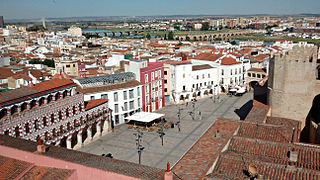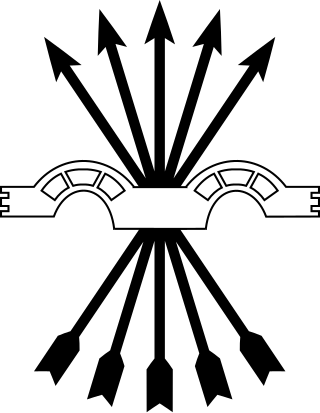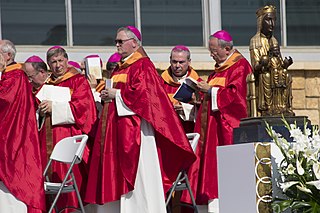Contents
This article needs additional citations for verification .(June 2014) |
| |||||
| Decades: | |||||
|---|---|---|---|---|---|
| See also: | Other events of 1936 List of years in Spain | ||||
This article needs additional citations for verification .(June 2014) |
| |||||
| Decades: | |||||
|---|---|---|---|---|---|
| See also: | Other events of 1936 List of years in Spain | ||||

Badajoz is the capital of the Province of Badajoz in the autonomous community of Extremadura, Spain. It is situated close to the Portuguese border, on the left bank of the river Guadiana. The population in 2011 was 151,565.

Infante Juan, Count of Barcelona, was a claimant to the Spanish throne as Juan III. He was the third son and designated heir of King Alfonso XIII of Spain and Queen Victoria Eugenie of Battenberg. His father was replaced by the Second Spanish Republic in 1931. Juan's son Juan Carlos I became king when Spain's constitutional monarchy was restored in 1975.

The Falange Española de las Juntas de Ofensiva Nacional Sindicalista was a fascist political party founded in Spain in 1934 as merger of the Falange Española and the Juntas de Ofensiva Nacional-Sindicalista. FE de las JONS, which became the main fascist group during the Second Spanish Republic, ceased to exist as such when, during the Civil War, General Francisco Franco merged it with the Traditionalist Communion in April 1937 to form the similarly named Falange Española Tradicionalista y de las JONS.

Infanta Pilar of Spain, Duchess of Badajoz and Viscountess of La Torre, sometimes known more simply as Pilar de Borbón, was the elder daughter of Infante Juan, Count of Barcelona and Princess María Mercedes of the Two Sicilies, and older sister of King Juan Carlos I.

The Mexican state of Nuevo León has been governed by more than a hundred individuals in its history, who have had various titles and degrees of responsibility depending on the prevailing political regime of the time.

Juan Yagüe y Blanco, 1st Marquis of San Leonardo de Yagüe was a Spanish military officer during the Spanish Civil War, one of the most important in the Nationalist side. He became known as the "Butcher of Badajoz" because he ordered thousands killed, including wounded Republican soldiers in the hospital.

Juan Guilloto León, usually referred to as Modesto or Juan Modesto, was a Republican army officer during the Spanish Civil War.

Francisco Ibáñez Talavera was a Spanish comic book artist and writer.

Francisco Javier Venegas de Saavedra y Ramínez de Arenzana, 1st Marquess of Reunión and New Spain, KOC was a Spanish general in the Spanish War of Independence and later viceroy of New Spain from September 14, 1810, to March 4, 1813, during the first phase of the Mexican War of Independence.

Jerónimo Saavedra Acevedo was a Spanish politician and academic. He served as President of the Canary Islands twice, from 1983 to 1987, and again from 1991 to 1993.

The siege of the Montaña Barracks was the two-day siege which marked the initial failure of the July 1936 uprising against the Second Spanish Republic in Madrid, on 18–20 July 1936, at the start of the Spanish Civil War. The bulk of the security forces in Madrid remained loyal to the government, and supported by workers' militias, crushed the uprising.

The symbols of Francoism were iconic references to identify the Francoist State in Spain between 1936 and 1975. They serve as visual illustrations for the ideology of Francoist Spain. Uniforms were designed for men and women that combined elements of the earlier Falangist and Carlist uniforms. The state developed new flags and escutcheons based on the traditional heraldry of the monarchy, but now associated with the state. The emblem of five arrows joined by a yoke was also adopted from earlier Spanish symbology, but after 1945 the arrows always pointed upward. This emblem appeared on buildings, plaques and uniforms.

The 522 Spanish Martyrs were victims of the Spanish Civil War beatified by the Roman Catholic Church on 13 October 2013 by order of Pope Francis. It was one of the largest number of persons ever beatified in a single ceremony in the Church's 2000-year history. They originated from all parts of Spain. Their ages ranged from 18 to 86 years old.
The Fifth Regiment was an elite corps loyal to the Spanish Republic at the onset of the Spanish Civil War. Made up of volunteers, the Fifth Regiment was active in the first critical phase of the war and became one of the most renowned units loyal to the Republic.

Saint Isidore Cemetery is a monumental cemetery in the Spanish capital Madrid. Its first courtyard was erected in 1811 and new expansions were added throughout the 19th Century. Its central courtyard, called "Patio de la Concepción" boasts a notable group of mausolea. This cemetery is the resting place of many famous Spaniards, including artists, politicians and poets.
Events in the year 2020 in Spain.

The Heraldo de Madrid was a Spanish daily newspaper published from 1890 to 1939, with an evening circulation. It came to espouse a Republican leaning in its later spell.
Francisco Laína García was a Spanish politician, who was the Director of State Security during the coup d'état of 23 February 1981. For 14 hours he headed the provisional government of Spain while Prime Minister Adolfo Suárez's government was sequestered in the Congress of Deputies.